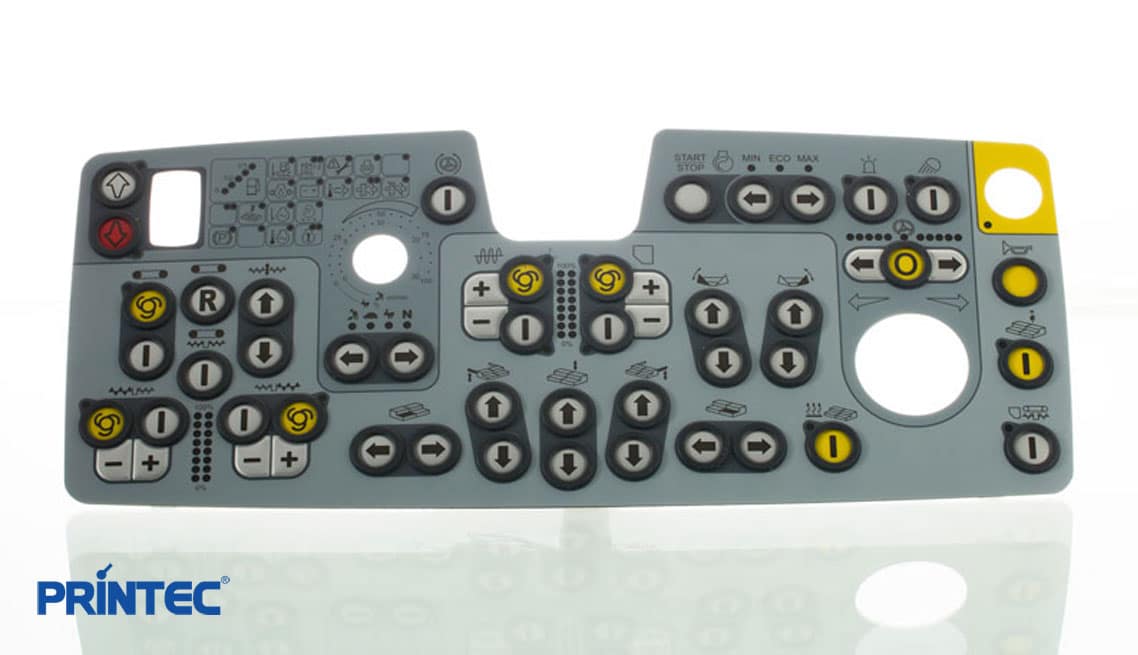The Ultimate Source on Membrane Changes: Design, Functionality, and Applications
Membrane switches offer as an intriguing crossway of style and capability, playing an essential role in modern user interfaces throughout various sectors. As we discover the varied applications of membrane buttons, it comes to be evident that their flexibility and longevity are critical in settings ranging from medical care to consumer electronic devices.

Comprehending Membrane Layer Buttons
Membrane layer switches are a kind of individual interface modern technology widely used in various electronic tools, identified by their slim, adaptable style and functionality. These switches are composed of several layers that include graphic overlays, sticky layers, and wiring, allowing a portable and efficient interface for individuals. They can be discovered in home appliances, clinical devices, and commercial control panels, offering a reputable approach for user communication.
Among the key advantages of membrane layer switches is their capacity to withstand pollutants such as dust and moisture, making them appropriate for environments where toughness is vital. Their inconspicuous style enables smooth integration right into various applications, while the adjustable visuals overlays enhance customer experience by supplying clear aesthetic feedback. Additionally, membrane switches can fit a variety of innovations, such as tactile feedback and backlighting, further improving their usability.
The manufacturing procedure for membrane layer switches over generally involves screen die-cutting, lamination, and printing strategies, guaranteeing accuracy and consistency in production. In general, membrane switches over represent a reliable and functional solution for contemporary electronic tools, incorporating capability with aesthetic allure in interface design.
Key Components and Design Elements
A range of essential components and design elements integrated to create a reliable membrane switch. At the core, the graphic overlay offers both aesthetic and practical functions, supplying an user-friendly user interface while securing interior elements from ecological elements. The choice of materials, generally polyester or polycarbonate, affects sturdiness and responsive comments.
Under the overlay, the adhesive layer makes sure the switch adheres firmly to the substrate, which can be glass, steel, or plastic. The spacer layer is vital, as it maintains the essential void in between the overlay and the circuit layers, permitting reliable actuation. Membrane Switches. Circuit traces, typically made from conductive ink or adhesive, are printed on an adaptable substrate, making it possible for electrical signals to be sent when stress is used
Design factors to consider likewise include the arrangement of responsive domes or embossing that provide physical comments to the individual, improving the overall experience. In addition, the design and spacing of the switches have to be maximized for simplicity of usage, guaranteeing that users can browse the interface without effort. Generally, these elements and layout aspects work synergistically to develop a reputable, functional membrane switch tailored to details applications.
Functionality and Operation Mechanism
At the heart of reliable functionality for membrane changes lies their operational device, which assists in individual interaction through a straightforward yet effective style. These buttons operate on the concept of why not look here stress activation, where a user applies pressure to an assigned location of the button (Membrane Switches). This action compresses the layers of the switch, completing an electrical circuit that sends a signal to the linked gadget
The building generally consists of a top visuals layer, a sticky spacer layer, and a bottom circuit layer, which jointly create click to find out more a durable interface. When stress is used, the leading layer falls down versus the bottom circuit layer, enabling conductive traces to link. This design not only enables clear tactile comments yet also ensures durability and reliability, as the buttons are commonly immune to dust and dampness.
Moreover, the flexibility of membrane switches enables for combination with different modern technologies, including LED indications and microcontrollers, enhancing their performance. By supplying a structured user interface that reduces mechanical wear, membrane layer switches continue to be a favored option in applications varying from consumer electronics to industrial devices, making certain optimal efficiency and customer complete satisfaction across varied settings.
Kinds Of Membrane Switches

One more substantial category is illuminated membrane buttons, which include backlighting to boost exposure in low-light conditions. These switches are typically utilized in control panels and control panels where clear presence is necessary.
Additionally, there are custom membrane layer switches over designed to meet particular dimensional, visual, and practical demands. These customizations can include one-of-a-kind shapes, shades, and designs, permitting smooth combination right into various gadgets.

Applications Throughout Numerous Industries
Just how do membrane layer switches improve performance throughout varied industries? In the clinical field, membrane layer switches play a crucial role in gadgets such as diagnostic devices and individual tracking systems, where reliability and ease of cleansing are critical.
In the vehicle sector, membrane buttons are commonly utilized in control panels and control panels, offering user-friendly controls that enhance vehicle driver safety and convenience. The consumer electronic devices sector likewise takes advantage of their customizable and lightweight functions, enabling sleek designs for smartphones and home appliances.
Additionally, membrane layer buttons discover applications in commercial automation, where they contribute to reliable equipment procedure and surveillance systems. Their resistance to dust and moisture ensures performance in demanding conditions (Membrane Switches). Additionally, the food and drink industry employs membrane layer switches for tools control, where health and sturdiness are vital
Verdict
In final thought, membrane layer changes represent an important technology in customer interface innovation, defined by their special style and capability. The adaptability of membrane switches promotes their application throughout varied industries, from medical gadgets to consumer electronics.
Membrane switches over offer as a fascinating junction of design and capability, playing a crucial function in modern-day individual interfaces throughout various industries.Membrane layer switches are a type of customer interface technology extensively used in different electronic devices, defined by their thin, flexible layout and capability.At the heart of reliable performance for membrane switches over exists their operational system, which promotes user interaction with a simple yet effective style. These buttons run on the concept of pressure activation, where a user applies pressure to a marked location of the switch.In conclusion, membrane switches represent a crucial technology in individual interface technology, defined by their unique layout and capability.
 Edward Furlong Then & Now!
Edward Furlong Then & Now! Danielle Fishel Then & Now!
Danielle Fishel Then & Now! James Van Der Beek Then & Now!
James Van Der Beek Then & Now! Richard Dean Anderson Then & Now!
Richard Dean Anderson Then & Now! Ricky Schroder Then & Now!
Ricky Schroder Then & Now!